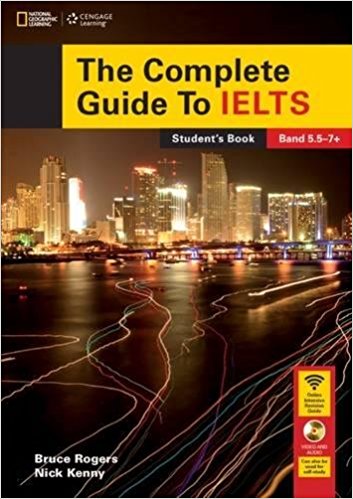The Complete Guide to IELTS, student’s book; Band 5.5-7+. Bruce Rogers, Nick Kenny
The Complete Guide to IELTS is a comprehensive guide to preparation of IELTS; the student’s book is divided into the following parts: Listening, Reading (academic), Writing (academic), Speaking.
At the back of each section is a practice test and at the end of the book there are support pieces covering grammar, sample writing, worksheets, video scripts. The Teacher’s book is divided in the same way.
The Student’s book is a comprehensive guide to the IELTS exam; it has numerous exercises with supporting vocabulary. Exercises are separated with `tips and tactics’ sections.
All modules are divided into sections and have examples of exam sections with little exercises to help the student understand key vocabulary and how to apply it. The Writing module prepares the student to learn objectives in segments. Each exercise is preceded with a list of words, synonyms and phrases that could be applied in writing with gapped tests and exam question samples. Speaking provides different ways of addressing the answer, supported by an audio that gives sample answers.
The student can build up their skills incrementally giving the teacher a means to phase any student into certain skill sets.
This book is good for an advanced level self-study student who has the time and motivation to go through the book. The `tips and advice’ is accurate but there are dis\advantages which I will explain later.
For the teacher, it is best used for 1: 1 teaching or as supplementary work in a rolling class. It could work in a closed, intensive class with a fixed enrolment date. Additionally, the teacher’s book gives excellent samples of writing showing the skills required to achieve as 5.5 and then, for instance, an 8.0.
Finally, the book provides additional study aids. However, some may have to be purchased in addition to the book.
This book is unsuitable for rolling enrolment classes for the simple reason that the book is not divided into units but into functions and skills. Other publications are divided into topics, e.g: art, history, science, etc. Each chapter covers all elements but related to the topic and provides complimentary vocabulary.
This book has no continuity or topic subjects but is merely a series of exercises. Using such a book requires greater organisation. In class, for example, the tutor will have to mark the pages in each section. For example, p16-12 (Listening), p66-67 (Reading), p180-181 (Writing), p260-261 (Speaking). The same style applies to the teacher’s book and the page numbers do not correspond to that of the student’s.
This means, that if you teach p261 of the student’s book, the corresponding answer in the teacher’s would not be on p261 but on a different page number. The consequence of this arrangement is any tutor has to make a series of bookmarks highlighting pages used or make detailed notes. The book arrangement can be confusing and difficult for a cover teacher to follow and understand.
Summary.
Advantages:
- Useful for the self-study student but only at a high level.
- Has a range of exercises and samples that would help a teacher guide the student incrementally through a process.
- Suitable for intensive 1:1 classes or closed classes.
- Excellent if used as supplementary material in a rolling class.
- `Tips and tactics’ page are accurate and would be useful to an IELTS teacher starting out.
- Range of additional information to access using a variety of media.
Disadvantages:
- No continuity, you cannot use it for a rolling class. There are no topics where you can explore all four exam elements with regard to a subject area.
- The layout is not user friendly. The text for advice is too detailed. An experienced teacher would be inclined not to use them.
- If used, it must only be by one teacher, sharing a class with another teacher only makes preparation confusing.
- Not for the disorganised.
